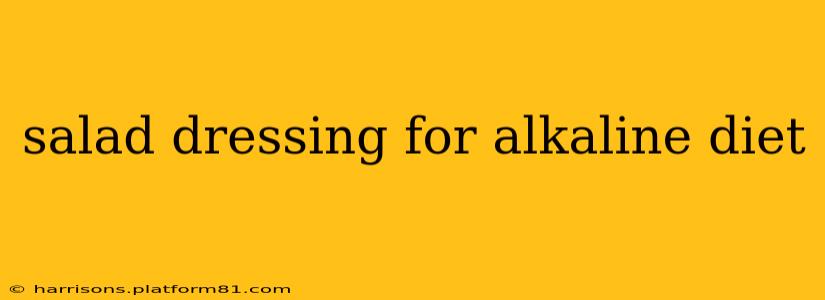Maintaining an alkaline diet requires careful consideration of food choices, and salad dressings are no exception. Many commercially available dressings are loaded with acidic ingredients that can disrupt your body's pH balance. Fortunately, creating delicious and healthy alkaline salad dressings is surprisingly easy. This guide will explore the best ingredients, offer some simple recipes, and address common questions surrounding alkaline salad dressings.
What Makes a Salad Dressing Alkaline?
The key to creating an alkaline salad dressing lies in selecting ingredients that have an alkaline-forming effect on the body. This doesn't mean the dressing itself needs to be alkaline (measured by pH); rather, it focuses on the body's metabolic response to the ingredients after digestion. Foods considered alkaline-forming are rich in minerals like potassium, calcium, magnesium, and sodium. Conversely, acidic-forming foods are high in phosphorus and sulfur.
Alkaline-forming ingredients ideal for dressings include:
- Avocados: Creamy and rich in healthy fats, avocados provide a wonderful base.
- Olive oil: A cornerstone of the Mediterranean diet, olive oil offers healthy fats and a mild flavor.
- Lemon juice (in moderation): Although citrus fruits are acidic, their metabolic effect is slightly alkaline-forming. Use sparingly.
- Herbs and spices: Fresh herbs like basil, parsley, cilantro, and dill add flavor and beneficial nutrients. Spices like turmeric and ginger can also boost the flavor profile and provide added health benefits.
What Ingredients Should I Avoid in Alkaline Salad Dressings?
Acidic ingredients should be minimized or avoided entirely when crafting alkaline salad dressings. These include:
- Vinegar: Most vinegars (apple cider, white, balsamic) are highly acidic.
- Processed oils: Many processed oils like soybean oil and canola oil are heavily processed and can be inflammatory.
- Refined sugars: Added sugars contribute to acidity and should be avoided.
- Mayonnaise: Commercial mayonnaise typically contains vinegar and other acidic ingredients.
What are Some Simple Alkaline Salad Dressing Recipes?
Here are a few easy recipes you can try:
1. Creamy Avocado Dressing:
- 1 ripe avocado
- ¼ cup olive oil
- 2 tablespoons lemon juice
- 1 tablespoon water (adjust for desired consistency)
- 1 clove garlic, minced
- Salt and freshly ground black pepper to taste
- Optional: Fresh herbs like cilantro or parsley
Blend all ingredients until smooth and creamy.
2. Simple Lemon-Herb Dressing:
- ¼ cup olive oil
- 2 tablespoons lemon juice
- 1 tablespoon fresh herbs (chopped parsley, dill, or basil)
- 1 teaspoon Dijon mustard (check for added sugar)
- Salt and pepper to taste
Whisk all ingredients together until well combined.
Is it Necessary to Use a Specific pH Meter for Alkaline Salad Dressings?
No, you don't need a pH meter to make alkaline-forming salad dressings. Focusing on choosing the right ingredients—those rich in alkaline-forming minerals—is more effective than attempting to measure the pH of the final dressing. The body's metabolic process, not the initial pH, determines the ultimate effect on your system.
Are all commercially available salad dressings acidic?
Yes, many commercially available salad dressings contain vinegar, added sugars, and other acidic ingredients, making them unsuitable for an alkaline diet. Always check the ingredient list carefully before purchasing.
Can I still enjoy a salad on an alkaline diet?
Absolutely! Salads are a fantastic part of an alkaline diet when dressed with the appropriate ingredients. Focusing on alkaline-forming vegetables and using the dressing recipes provided ensures your salad supports your dietary goals.
This guide offers a starting point for incorporating alkaline salad dressings into your diet. Remember to always consult with a healthcare professional or registered dietitian before making significant changes to your diet, especially if you have underlying health conditions. Experiment with different herbs, spices, and ingredients to find your perfect alkaline salad dressing!
